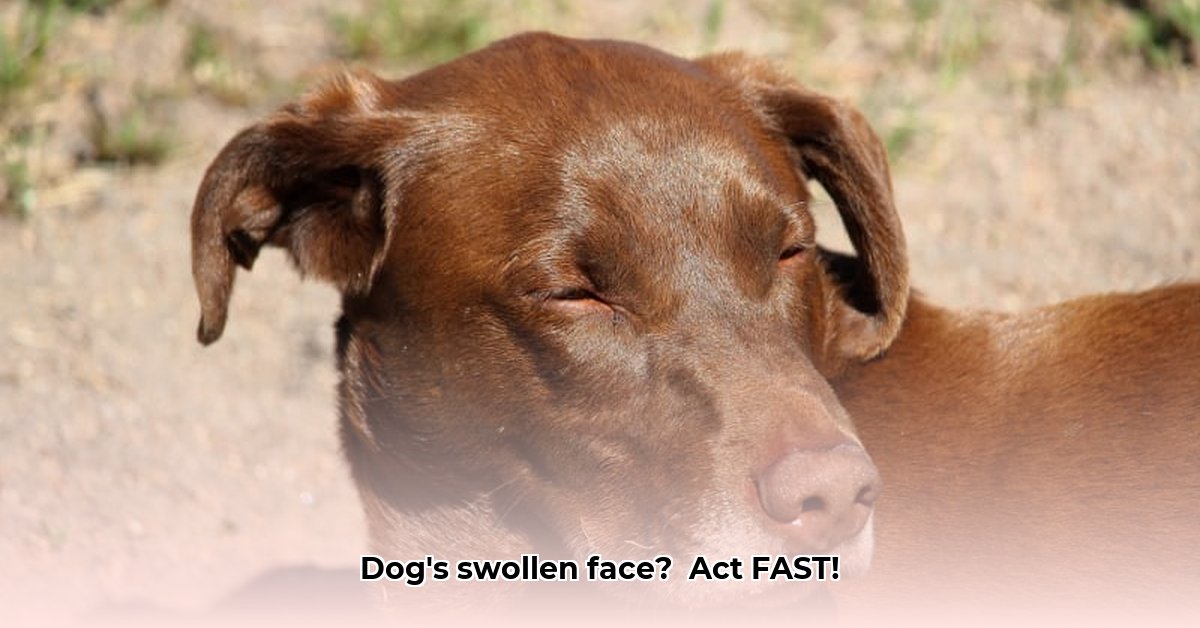Worried about your dog’s puffy face? A swollen face in dogs can be alarming, but understanding the causes and knowing when to seek help is essential. This guide helps you navigate the potential reasons behind your dog’s facial swelling, from minor issues like insect bites to more serious underlying conditions. We’ll explore identifying the problem, deciding when a vet visit is crucial, and providing safe home care (always under veterinary guidance). Plus, we’ll share tips for preventing future occurrences. Whether it’s a sudden emergency or you’re simply aiming to maintain your pup’s health, this resource is here for you.
Dog Swollen Face: When to Worry and What to Do
Discover when a dog’s swollen face requires urgent veterinary attention, and learn the immediate steps you can take to ensure their well-being. A puffy face in dogs can stem from various causes, making it crucial to discern the severity and act accordingly.
Understanding Why Your Dog’s Face is Swollen
Many factors can lead to swelling in a dog’s face. Here are some common causes:
- Allergies: Dogs, like humans, can be allergic to environmental factors (pollen, dust mites), foods (chicken, beef, soy), medications, insect bites, or even grooming products. Allergic reactions trigger the release of histamine, leading to facial swelling, itching, hives, and, in severe cases, difficulty breathing. This resembles a human’s allergic reaction but affects the face, often around the muzzle and eyes.
- Infections: Infections such as abscesses (pus-filled pockets often caused by bite wounds or foreign objects), tooth infections (affecting the roots and gums), cellulitis (bacterial skin infection), or more severe conditions can induce swelling and inflammation. These infections act like a severe splinter causing a swollen finger, but affect a dog’s facial area. Untreated infections can spread, leading to serious complications.
- Injuries: Falls, fights with other dogs or animals, blunt trauma (getting hit by a car), foreign objects (splinters, plant awns), or accidental bumps can cause facial swelling and bruising. The swelling is a result of inflammation and fluid accumulation in the tissues. Always inspect your dog’s face for any cuts or scrapes that might indicate an injury.
- Dental Problems: Advanced gum disease (periodontitis), tooth root abscesses, fractured teeth, or impacted teeth can result in swelling around the jaw and mouth. Bacteria from dental infections can enter the bloodstream, affecting organs. Regular dental checkups are essential as these issues may not be immediately apparent. Signs include bad breath, drooling, and difficulty eating.
- Bug Bites and Stings: Insect stings from bees, wasps, hornets, or spider bites commonly cause localized swelling. The venom injected can trigger an allergic reaction, leading to inflammation. Allergic dogs may experience more pronounced swelling, hives, and even anaphylaxis. Check for a stinger at the site.
- Tumors and Cysts: Tumors, both benign (non-cancerous) and cancerous (malignant), can cause facial swelling as they grow. Cysts (fluid-filled sacs) can also cause noticeable swelling. Early detection and diagnosis are critical in these cases. Monitor for changes in size, shape, and consistency.
- Craniomandibular Osteopathy (CMO): This is a genetic bone disease primarily affecting young dogs, especially West Highland White Terriers and other terrier breeds. It causes abnormal bone growth in the skull and jaw, leading to facial swelling, pain, and difficulty opening the mouth.
- Salivary Gland Issues: Blockage or inflammation of the salivary glands can cause swelling under the jaw or in the neck area. This can be due to injury, infection, or a foreign object.
- Craniomandibular Osteopathy: More common in Westies and other terrier breeds.
- Masticatory Myositis: An inflammatory disease affecting the muscles used for chewing, leading to swelling and pain in the jaw area.
When a Swollen Face is a True Emergency
Certain symptoms accompanying a swollen face necessitate immediate veterinary attention. Call your vet or visit an emergency animal hospital immediately if you observe any of the following:
- Trouble Breathing: This is a critical emergency, as swelling in the throat or airway can obstruct airflow. Signs include rapid breathing, labored breathing, gasping, or blue gums. Difficulty breathing is a major red flag and requires prompt action to prevent suffocation.
- Excessive Drooling: While some drooling is normal, sudden and excessive drooling can indicate pain, discomfort, nausea, or a serious underlying issue like a foreign object in the mouth or a neurological problem. Increased salivation always requires veterinary evaluation.
- Lethargy and Weakness: A sudden decrease in your dog’s energy levels, accompanied by weakness or reluctance to move, requires a vet visit. Changes in energy indicate a possible infection, pain, or organ dysfunction. Severe lethargy can be a sign of shock.
- Vomiting and Diarrhea: These symptoms alongside facial swelling often indicate a serious underlying problem, such as a severe allergic reaction (anaphylaxis), infection, or ingestion of a toxin. Especially concerning if there is blood in the vomit or stool.
- High Fever: A fever (over 103.5°F or 39.7°C) suggests the dog’s body is battling a significant infection or illness. Use a rectal thermometer to accurately measure your dog’s temperature. A fever is a dangerous sign and requires immediate veterinary intervention.
- Collapse: If your dog collapses, it’s a life-threatening situation demanding immediate emergency care, potentially signaling anaphylaxis (a severe allergic reaction), shock, heart failure, or a neurological problem. Anaphylaxis can constrict airways.
- Pale Gums: Pale or white gums indicate poor circulation and can be a sign of shock, internal bleeding, or anemia. This is a critical sign requiring immediate veterinary attention.
- Seizures: Uncontrolled shaking or twitching indicates a neurological problem that requires immediate veterinary attention.
- Inability to Open Mouth: This suggests severe pain, swelling, or muscle dysfunction in the jaw, warranting immediate veterinary intervention.
- Bleeding: Any uncontrolled bleeding from the face or mouth requires immediate veterinary attention.
What You Can Do at Home (But Always, Always Call the Vet First!)
While home care can’t replace professional veterinary treatment, certain first-aid measures can provide comfort until you get to a vet. Always consult your veterinarian immediately before administering any medication or treatment.
- Contact Your Veterinarian: Before doing anything else, call your vet. Explain the situation and symptoms, and follow their specific advice. They can determine the urgency of the situation and guide you on the best course of action.
- Cold Compress: Apply a cool, damp cloth (never direct ice) to the swollen area for 10-15 minutes at a time to help reduce inflammation and pain, similar to using a cold pack for a sprain. This is most effective in the early stages of swelling.
- Gentle Cleaning: If there are any open wounds or discharge, gently clean the area with a mild antiseptic solution (such as diluted povidone-iodine) to prevent infection.
- Remove Potential Allergens: If you suspect an allergic reaction, remove any potential allergens from your dog’s surroundings (e.g., new food, plants, cleaning products).
- Elevation: Gently elevate your dog’s head if it’s safe and comfortable to help reduce swelling. Use a pillow or rolled-up towel.
- Careful Observation: Closely monitor your dog, noting any changes in behavior, swelling, or other symptoms (breathing, appetite, energy level), and report them immediately to your veterinarian.
- Benadryl (Diphenhydramine): Only if your veterinarian advises it, you can administer Benadryl (diphenhydramine) for suspected mild allergic reactions. Always confirm the correct dosage with your vet, as it varies based on your dog’s weight. Be aware that Benadryl can cause drowsiness.
- EpiPen: Only if your dog has had a previous anaphylactic reaction and your veterinarian has prescribed an EpiPen, administer it according to their instructions. Immediately seek emergency veterinary care after administering an EpiPen, as it only provides temporary relief.
- Do NOT Give Human Pain Relievers: Never give your dog human pain relievers like ibuprofen (Advil, Motrin) or acetaminophen (Tylenol), as they can be toxic to dogs.
What Your Vet Will Do
Diagnosing the cause of facial swelling typically involves a detailed process, encompassing a thorough physical exam, detailed history, and diagnostic testing:
- Detailed History: Your vet will inquire about recent events, diet changes, potential allergen exposure (new foods, plants, insects), recent medications or vaccinations, history of allergies or medical conditions, and any other symptoms to gather relevant information.
- Physical Exam: Your vet will examine your dog’s face, checking for pain, swelling extent, symmetry, discharge, wounds, dental health, lymph node size, and other abnormalities to assess the condition. They will also check vital signs (temperature, heart rate, respiratory rate).
- Tests: Depending on the vet’s assessment, they may
- Gluten Free Meal Prep Ideas for Delicious, Hassle-Free Eating - November 28, 2025
- Gluten Free Meal Prep for Stress-Free and Healthy Eating - November 27, 2025
- Quick And Easy Chicken Thigh Meal Prep For Weight Loss - November 26, 2025










